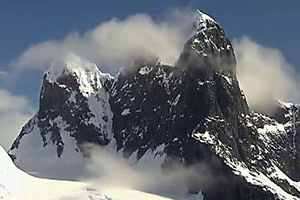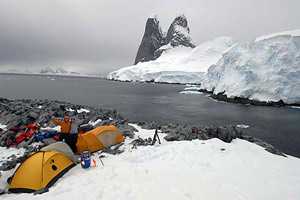
The western side of the Three Pigs or False Cape Renard. The Basque team made the first ascent of the highest of the three summits, christened Zerua Peak via Azken Paradisua (5.11d M6 90 degrees, 600m, Baraiazarra-Pou-Pou, 2007). The climb completed the Pou brothers’ Seven Walls – Seven Continents quest. [Photo] Courtesy of www.pouanaiak.com
As a climax to their Seven Walls – Seven Continents project, the Pou brothers have just climbed an important new route on the Antarctic Peninsula. In a twenty-four-hour round trip from their base camp in the Lemaire Channel, Eneko and Iker Pou made the first ascent of the “Three Pigs” via a route they have named Azken Paradisua, a 400-meter rock wall followed by 200 meters of mixed and ice terrain to the summit mushroom.
The Basque climbers crossed the Drake Passage and sailed down the Peninsula on Northanger (the 54-foot vessel featured in “Elsewhere,” Issue 19), negotiating the usual iceberg hazard until reaching Cape Renard at the entrance to the Lemaire Channel. This passage, between the mainland and Booth Island, is often referred to as Kodak Gap due to the spectacular scenery, which makes it possibly Antarctica’s most photographed water way by the passengers of the now many cruise ships that frequent this area. The Basques established a base camp on the ice just 20 meters above the sea and close to a collection of icy rock towers known as False Cape Renard or the “Three Pigs.”
After thorough reconnaissance the two made their first attempt on December 21, but high winds and snow fall forced them down after Eneko had taken a short fall from an icy crack. When this weather cleared, they left for a second try at 7:30 p.m. on Christmas Eve, climbing the 250m of vertical height that separated the western foot of the wall from the sea. This was glaciated terrain with ice steepening to 70 degrees toward the finish. The 400m rock wall was climbed in ten pitches, the first three with maximum difficulties of 5.8/5.9, a fourth pitch crux of 5.11d, then two pitches of 5.10, a pitch of easy 5.11, and then three more starting at 5.10 and gradually diminishing to 5.5/5.6. From this point a steep ice pitch (70 degrees) lead to a rock wall, climbed at 10c. Above, three more pitches with a crux of 90 degrees and 5.8, led to the top. The route was climbed on natural gear and descent made by rappel, in six hours via a different line, from pegs and slings, etc. The wall itself took thirteen hours to climb, the pair finally regaining their camp, exhuasted, at 7:30 p.m. on Christmas Day. The weather on the Peninsula is often very fickle and the Basques preferred to go for a continuous push rather than risk a bivouac on the wall.
The brothers, who are primarily superb rock climbers, found this climb the most adventurous they’ve done: the conditions were harsh, with low temperatures and constant wind; they were unsure of what they would find on the route, and realized that rescue in this part of the world is an extremely tenuous business. They have named the previously unclimbed tower, Zerua Peak.

Base Camp in the Lemaire Channel with False Cape Renard (aka the Three Pigs) behind. [Photo] Courtesy of www.pouanaiak.com
A little to the north, at the northeastern end of the Lemaire Channel, generally referred to as Cape Renard, stands the impressive double-summited Cape Renard Tower (747m), traditionally referred to by British Antarctic Survey employees as Una’s Tits (don’t ask!). It is an impressive icy rock tower, in common with the other formations in this region formed of basalt, and was attempted by British parties via the north face before the successful first ascent in February 1997 by Canadians Jia Condon and Rich Prohaska. This pair climbed the East Buttress, a route on which they fixed ropes and overcame difficulties of 5.9 and A2 before reaching the East Summit. The continuation along the short but corniced connecting ridge to the slightly higher West Top looked too dangerous, so they descended, naming their route Una’s What? and leaving the first ascent of the highest point to a German team two years later. In 1999 Kurt Albert, Stefan Glowacz, Hans Martin Gotz, Gerhard Heidorn, Holger Heuber and Jurgen Knappe climbed the southwest face directly to the highest summit to create a seventeen-pitch pure rock route at 5.11d/12a.
The Pou brothers conceived the idea of the the Seven Walls – Seven Continents project in 2002, when they decided to travel to each of the world’s seven continents and free climb a significant rock wall that was representative of the land they were in. In 2003 they completed the first two stages with free ascents of El Nino on El Cap and Zunbeltz on the Naranjo de Bulnes in northern Spain’s Picos de Europa. The following year they journeyed to Madagascar and managed the first free ascent of Bravo les Filles in the Tsaranoro massif. In 2005 it was the turn of Australasia and the famous Totem Pole off Tasmania, Australia [Thank you, readers, for the correction. –Ed.]. That same summer they traveled to Pakistan for their most ambitious project at the time, the first free ascent of Eternal Flame on Trango Tower. Although they completed the ascent of this increasingly popular Karakoram route, they failed to climb every pitch free. Their sixth continent was South America, where on their second attempt they made a free ascent of the Supercanaleta on Fitz Roy.
Sources: Greg Landreth, Keri Pashuk, www.pouanaiak.com